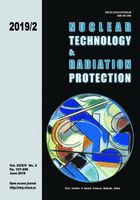
EVALUATION OF THE GAMMA DOSE RATE INSIDE EGYPTIAN BUILDINGS UTILIZING THEORETICAL AND EXPERIMENTAL TECHNIQUES
Pages: 175-180
Authors: Elsayed Salama and Hala A. SolimanAbstract
The indoor low gamma dose rate exposures due to Egyptian room building materials are assessed by means of three different techniques: experimentally by using a thermoluminescent dosimeter, theoretically by using the general room model and by the Monte Carlo simulation through the RESRAD-BUILD software. The present study aims at validating the theoretical methods so that it can be amply used for measuring the low dose rates usually associated with the building materials. The measured indoor dose rates were in the range of 55.92 ± 14.47 to 86.89 ± 16.68 nGyh-1 depending on the position inside the room as obtained by the thermoluminescent dosimeter after 5 months' accumulation. Lower dose rates are obtained near the door and windows while higher dose rates are obtained at the center of the room, and close to the extended walls. Comparable results of the dose rates at same positions inside the room are obtained by the RESRAD-BUILD software. The room model is restricted to the room center and also gives comparable results. The three methods showed comparable results, which in turn confirm the recommendation of using theoretical ones, with RESRAD-BUILD software being more accurate.
Key words: dose rate, Egyptian building material, room model, RESRAD-BUILD software, TLD dosimeter
FULL PAPER IN PDF FORMAT (847 KB)
